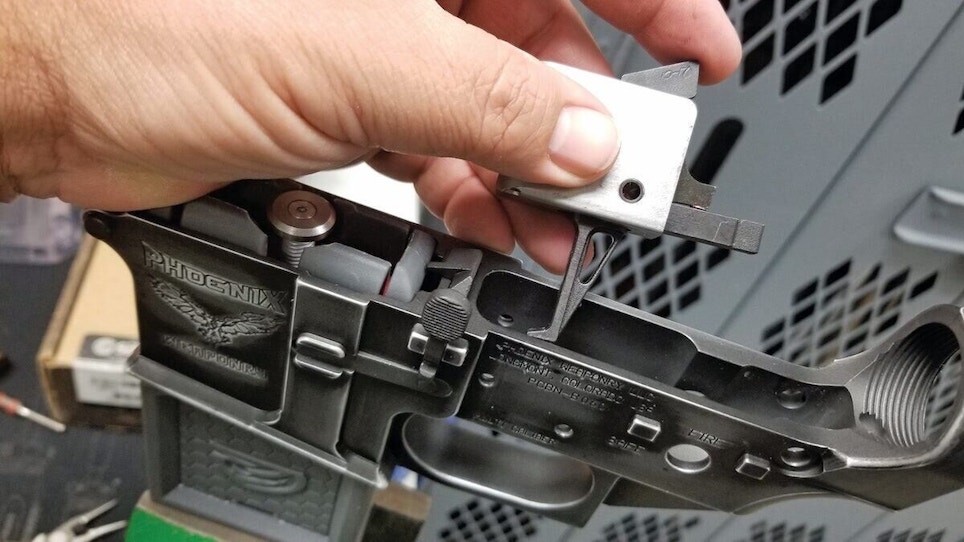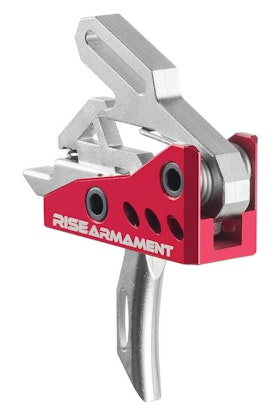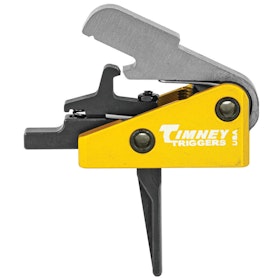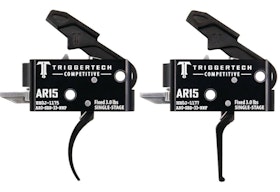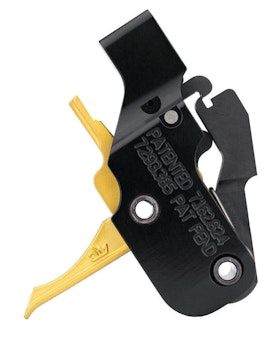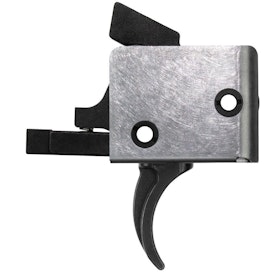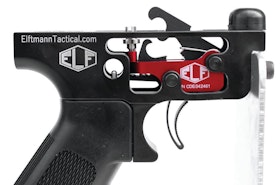Aftermarket triggers are all the rage, especially for those shooting “America's Rifle”— the AR-15. And among all those aftermarket options, drop-in triggers — where all the components are put together in a single, standalone unit — are among the most popular.
There’s a good reason why: These triggers are far, far better than mil-spec triggers that typically come stock in most AR-15 models. And best of all, drop-in triggers are so simple to install that no professional gunsmithing is needed.
Before we take a look at some top models to offer your customers, let’s review a bit about AR triggers and how they work.
Mil-Spec Triggers
Triggers that come standard in most AR models, at least base models, are termed mil-spec. Since the basis for the AR-15 was designed around these mil-spec triggers, they are certainly quite functional. And, if you’ve never shot anything else you might think they are quite good. But once you’ve tried a top-quality aftermarket trigger, the next time you shoot a gun with a mil-spec trigger you’ll likely notice the gritty feel and the extremely long, heavy trigger pull that leaves you unsure of exactly when the round is going to be discharged.
Since the trigger in any gun has such a big impact on accuracy, it’s important to understand how a mil-spec trigger on an AR-style gun works. A mil-spec trigger system is made up of eight different parts — hammer, trigger (which has the sear surface on it), disconnector, hammer spring, trigger spring, disconnector spring and the two pins that hold it all together in the lower receiver.
In a nutshell, the hammer starts out in the forward position. When you charge the rifle by pulling back the charging handle, it moves the hammer to the rearward position. This engages the trigger. The very front of the trigger (the sear) is now engaged into a small notch on the hammer. When the trigger is pulled, the front of the trigger moves downward, disengaging from the hammer and allowing the hammer to spring forward and strike the firing pin. After each shot, the bolt carrier group moves back and re-cocks the hammer, leaving the gun ready to fire again.
The typical mil-spec trigger doesn’t have a smooth, clean break because the sear surfaces are not very smooth, causing the longer pull and gritty feeling so common with those triggers. These surfaces can be cleaned and polished, but doing so is better done by a gunsmith. While that will make things smoother, it doesn’t help with the heavy pull required, and most mil-spec AR triggers take about 5.5 to 9.5 pounds of pull to fire. On the flip side, many drop-in aftermarket trigger units start around 3 pounds, and some are even user adjustable.
Now, let’s look at seven very good drop-in trigger units that don’t require a gunsmith to install and that your customers might find to their liking.
Rise Armament 535 Advanced Performance Trigger
If you haven’t heard of Rise Armament, based in Broken Arrow, Oklahoma, you’re missing out on some trigger news of epic proportions. The company, which started out in the aerospace industry, now has several different drop-in trigger designs with different features at a variety of price points.
Of all the triggers I’ve shot — and that’s a bunch over the past several years — the Rise 535 APT, Rise’s top-of-the-line trigger, is undoubtedly one of the very best. My son and I installed one in an AR he was building and it is smooth, crisp and everything you’d want in an aftermarket trigger. The trigger breaks at about 3.5 pounds like the proverbial glass rod so often overused in trigger comparisons. The single-stage trigger offers straight trigger functionality with curved trigger comfort. And the lightning fast reset ensures the operator will be back on target quickly. The 535 APT comes with free anti-rotational pins and retails for $260.
Rise Armament Iconic
I hate to double up on a manufacturer, but Rise Armament’s new Iconic trigger is also well worth talking about. Unlike the 535 AP, the Iconic is a two-stage trigger, which means it requires an extra pull range to facilitate firing. The trigger is initially pulled until the trigger pull weight changes; pulling beyond that point discharges the firearm. In the Iconic, the first stage takes about 1.5 pounds of pull, then the second stage breaks right at about 2 pounds.
While many two-stage triggers lack the snappy reset of one-stage modules, the Iconic retains a very good reset to allow for quick follow-up shots. The trigger unit features a wide, comfortable front blade. The hammer is made of black, Nitride-finished tool steel, and all the components are secured in a 6061 aerospace aluminum housing. MSRP is a stiff $299, but customers looking for a two-stage trigger will likely love this one.
Timney AR-15 Competition Trigger
Timney has been a top name in triggers for more than three-quarters of a century, and the company’s drop-in trigger units for AR-15 rifles are among the best. And while this trigger has “Competition” in the name, it is equally good for sport shooting, hunting and even casual range use. I put this trigger in my very first AR build, all the while grousing about the price. But after I shot the gun for the first time I knew it was well worth the money. The Timney is available with a curved, straight or skeletonized trigger in pull weights of 3, 4 and 5.5 pounds, giving users the ability to choose which is right for them and their purpose. It delivers an exceptionally smooth, crisp, creep-free single-stage trigger pull that can allow an AR to achieve its best accuracy. The hammer is made of wire-EDM machined from S7 tool steel, and all components are captured in a lightweight aluminum alloy housing. MSRP starts at $225 and varies depending on preferred features.
TriggerTech Single-Stage AR Trigger
To make their new single-stage AR trigger, this Canadian company started with their proven two-stage AR platform trigger that haS been in the field since 2016 and combined it with a serious amount of ingenuity from their engineering department. And that ingenuity has paid off in spades with a zero-creep, single-stage AR trigger that is quickly becoming very popular. In a departure from other trigger manufacturers, TriggerTech makes use of a patented, free-floating roller that is captured between the sear and the ticker. This advancement makes it possible to eliminate all creep — a major bugaboo of mil-spec AR triggers. The unit features a flat, straight trigger with key components made from 440C stainless steel and housed in 7075 anodized aluminum body and uses standard mil-spec pins. And best of all, the pull weight can easily be adjusted by the user in 2-ounce increments using a set screw with the trigger still installed. MSRP starts at $235.
AR Gold Adjustable Trigger
Back when I was shooting 3-gun competitions regularly, I decided to build a lighter, faster rifle since most of the stages at my local club were burn-’em-down types of affairs. After an exhaustive deep dive into available triggers, I landed on what most of the other guys were shooting — the AR Gold — and never regretted that decision. Here we’ll look at an improvement of that trigger that is not only top quality like the original but also adjustable. The AR Gold comes stock with a 3.5-pound pull weight and is available in both flat and curved trigger faces. More than just the lightweight pull, the manufacturer says the trigger has the shortest reset and cleanest break of any trigger on the market, and I certainly wouldn’t argue with that. The trigger is adjustable for both pull weight and overtravel length. The company also touts the AR Gold as being “drop safe,” which can’t be a bad thing. MSRP of the AR Gold Adjustable Trigger is $280.
CMC Triggers Single-Stage
CMC Triggers is the original manufacturer of the drop-in trigger group for the AR-15/10 rifle and has been making them since 2003. The company’s success has been at least somewhat attributable to the fact that their critical sear engagement surfaces have a proprietary machining process that renders superior surface finish and dimensional control, leading to a crisper, more consistent trigger break.
According to the company, minimal lock time is designed into the assembly using controlled hammer weight and balance activated by a rocket wire hammer spring, assuring repeatable function with either commercial or military-grade ammunition. Internal parts are made from 8620 alloy steel and S7 tool steel assembled in a stainless steel housing. Customers can choose either small-pin or large-pin mounting options and factory-set trigger pull weights of 2.5, 3.5, 4.5, 5.5 or 6.6 pounds. MSRP for the CMC trigger is $190, making it the least expensive of all the triggers discussed.
Elftmann Tactical Trigger
Pull weight of this trigger is easily adjustable from 2.75 to 4 pounds without the need to remove the trigger from the lower receiver. The trigger features an incremental adjustment knob so users can adjust the pull weight in increments simply by turning it with their fingers or a flat tool/coin. The spring in the housings and the notch on the adjustment screw do not allow the trigger tension to change its settings without manually setting it and will not allow it to back out. It is also absolutely drop safe regardless of pull weight. Elftmann boasts that the trigger’s amazingly short takeup, glass-rod crisp break and next to zero overtravel can be compared to the finest custom 1911 triggers. And the proprietary Double-Double torsion hammer spring and heavy hammer ensure proper ignition of all ammunition. The trigger is available straight or curved and in either large or standard pin size. It’s made in the USA and has a lifetime warranty. MSRP is $259.
